Report on Understanding and Leading Change at Sainsbury's: Analysis
VerifiedAdded on 2020/12/31
|14
|4313
|442
Report
AI Summary
This report analyzes change management within Sainsbury's, a major UK supermarket chain, addressing the impact of changes on organizational strategy and operations, including technological advancements and structural modifications. It explores the influence of internal drivers such as organizational culture, resources, and financial management, and external drivers including political, economic, social, and technological factors (PEST analysis), on leadership, team, and individual behavior. The report also examines measures to minimize the negative impacts of change, utilizing the PDCA model for effective management. Furthermore, it investigates barriers to change and their effect on leadership decision-making and explores the contribution of different leadership approaches to organizational change initiatives. The report concludes with recommendations for successful change management within Sainsbury's, highlighting the importance of adapting to internal and external factors to ensure sustained business growth and performance.
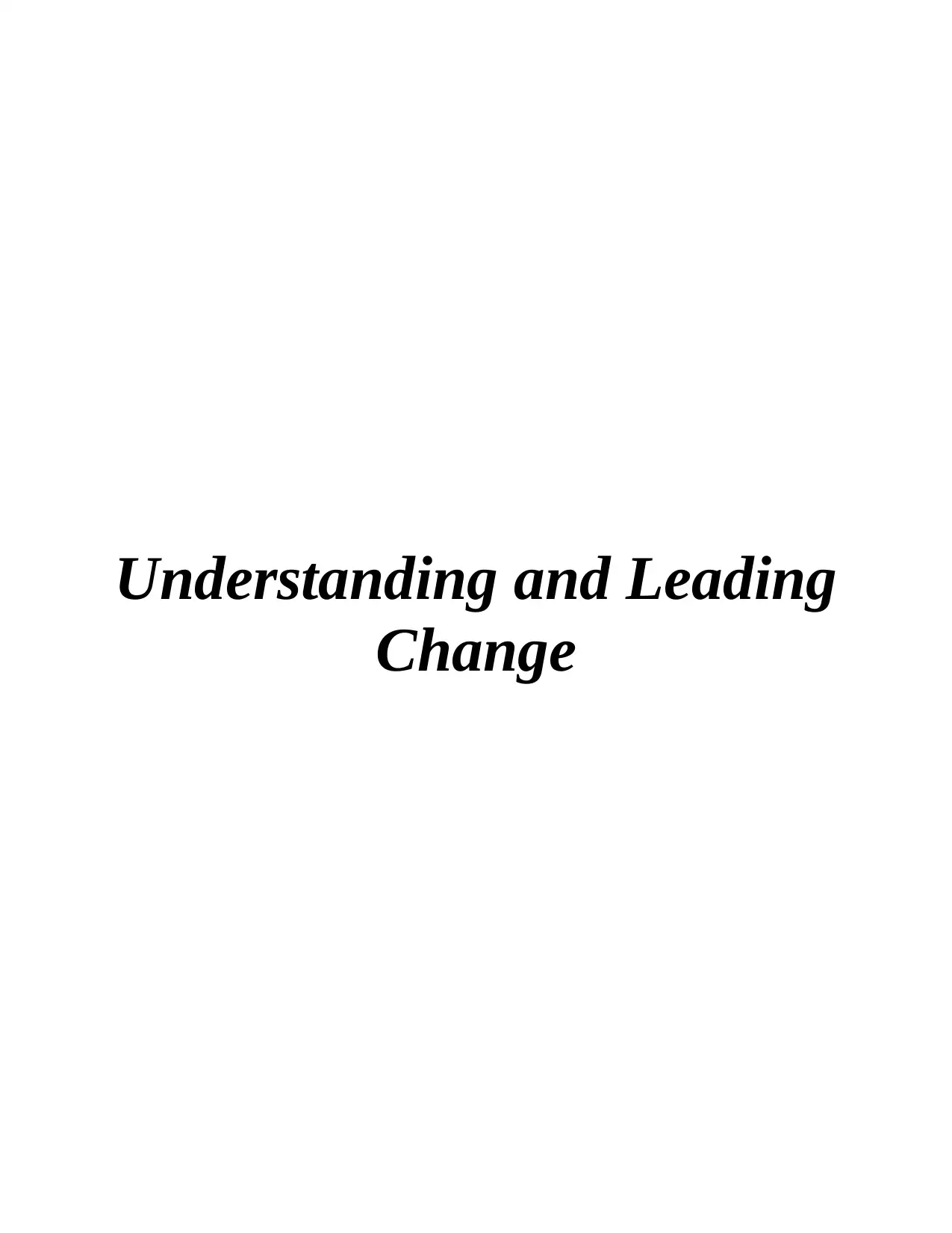
Understanding and Leading
Change
Change
Paraphrase This Document
Need a fresh take? Get an instant paraphrase of this document with our AI Paraphraser
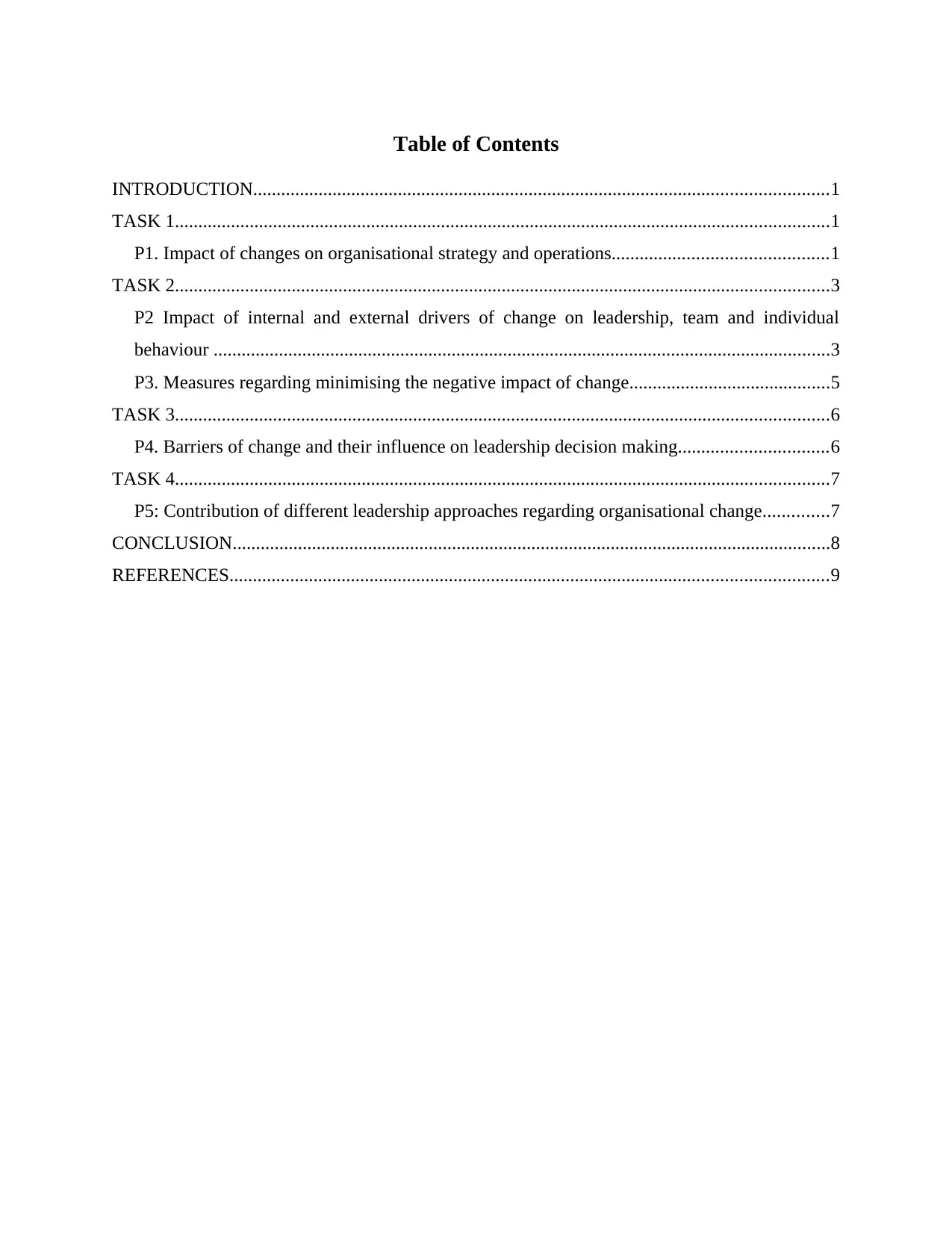
Table of Contents
INTRODUCTION...........................................................................................................................1
TASK 1............................................................................................................................................1
P1. Impact of changes on organisational strategy and operations..............................................1
TASK 2............................................................................................................................................3
P2 Impact of internal and external drivers of change on leadership, team and individual
behaviour ....................................................................................................................................3
P3. Measures regarding minimising the negative impact of change...........................................5
TASK 3............................................................................................................................................6
P4. Barriers of change and their influence on leadership decision making................................6
TASK 4............................................................................................................................................7
P5: Contribution of different leadership approaches regarding organisational change..............7
CONCLUSION................................................................................................................................8
REFERENCES................................................................................................................................9
INTRODUCTION...........................................................................................................................1
TASK 1............................................................................................................................................1
P1. Impact of changes on organisational strategy and operations..............................................1
TASK 2............................................................................................................................................3
P2 Impact of internal and external drivers of change on leadership, team and individual
behaviour ....................................................................................................................................3
P3. Measures regarding minimising the negative impact of change...........................................5
TASK 3............................................................................................................................................6
P4. Barriers of change and their influence on leadership decision making................................6
TASK 4............................................................................................................................................7
P5: Contribution of different leadership approaches regarding organisational change..............7
CONCLUSION................................................................................................................................8
REFERENCES................................................................................................................................9
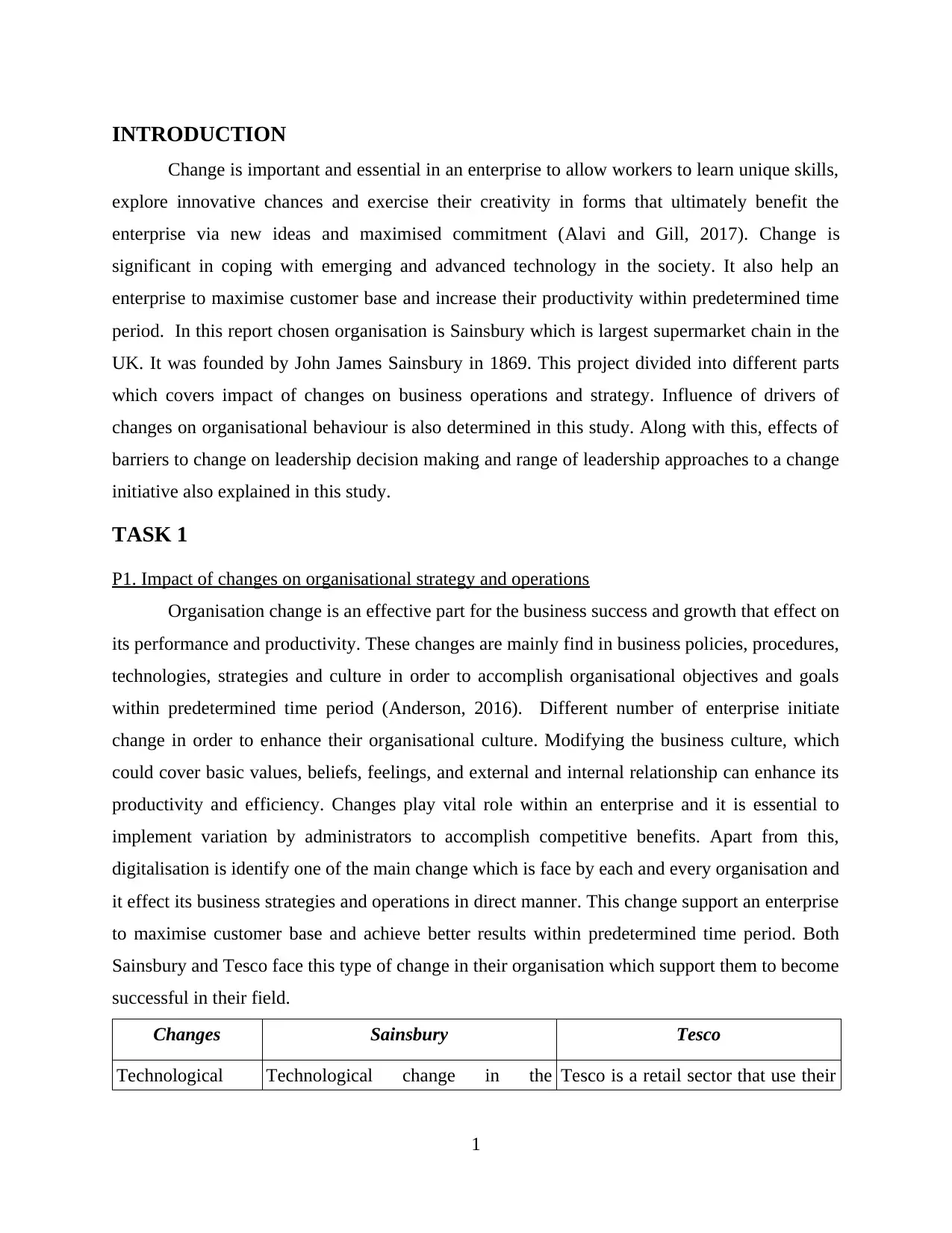
INTRODUCTION
Change is important and essential in an enterprise to allow workers to learn unique skills,
explore innovative chances and exercise their creativity in forms that ultimately benefit the
enterprise via new ideas and maximised commitment (Alavi and Gill, 2017). Change is
significant in coping with emerging and advanced technology in the society. It also help an
enterprise to maximise customer base and increase their productivity within predetermined time
period. In this report chosen organisation is Sainsbury which is largest supermarket chain in the
UK. It was founded by John James Sainsbury in 1869. This project divided into different parts
which covers impact of changes on business operations and strategy. Influence of drivers of
changes on organisational behaviour is also determined in this study. Along with this, effects of
barriers to change on leadership decision making and range of leadership approaches to a change
initiative also explained in this study.
TASK 1
P1. Impact of changes on organisational strategy and operations
Organisation change is an effective part for the business success and growth that effect on
its performance and productivity. These changes are mainly find in business policies, procedures,
technologies, strategies and culture in order to accomplish organisational objectives and goals
within predetermined time period (Anderson, 2016). Different number of enterprise initiate
change in order to enhance their organisational culture. Modifying the business culture, which
could cover basic values, beliefs, feelings, and external and internal relationship can enhance its
productivity and efficiency. Changes play vital role within an enterprise and it is essential to
implement variation by administrators to accomplish competitive benefits. Apart from this,
digitalisation is identify one of the main change which is face by each and every organisation and
it effect its business strategies and operations in direct manner. This change support an enterprise
to maximise customer base and achieve better results within predetermined time period. Both
Sainsbury and Tesco face this type of change in their organisation which support them to become
successful in their field.
Changes Sainsbury Tesco
Technological Technological change in the Tesco is a retail sector that use their
1
Change is important and essential in an enterprise to allow workers to learn unique skills,
explore innovative chances and exercise their creativity in forms that ultimately benefit the
enterprise via new ideas and maximised commitment (Alavi and Gill, 2017). Change is
significant in coping with emerging and advanced technology in the society. It also help an
enterprise to maximise customer base and increase their productivity within predetermined time
period. In this report chosen organisation is Sainsbury which is largest supermarket chain in the
UK. It was founded by John James Sainsbury in 1869. This project divided into different parts
which covers impact of changes on business operations and strategy. Influence of drivers of
changes on organisational behaviour is also determined in this study. Along with this, effects of
barriers to change on leadership decision making and range of leadership approaches to a change
initiative also explained in this study.
TASK 1
P1. Impact of changes on organisational strategy and operations
Organisation change is an effective part for the business success and growth that effect on
its performance and productivity. These changes are mainly find in business policies, procedures,
technologies, strategies and culture in order to accomplish organisational objectives and goals
within predetermined time period (Anderson, 2016). Different number of enterprise initiate
change in order to enhance their organisational culture. Modifying the business culture, which
could cover basic values, beliefs, feelings, and external and internal relationship can enhance its
productivity and efficiency. Changes play vital role within an enterprise and it is essential to
implement variation by administrators to accomplish competitive benefits. Apart from this,
digitalisation is identify one of the main change which is face by each and every organisation and
it effect its business strategies and operations in direct manner. This change support an enterprise
to maximise customer base and achieve better results within predetermined time period. Both
Sainsbury and Tesco face this type of change in their organisation which support them to become
successful in their field.
Changes Sainsbury Tesco
Technological Technological change in the Tesco is a retail sector that use their
1
⊘ This is a preview!⊘
Do you want full access?
Subscribe today to unlock all pages.

Trusted by 1+ million students worldwide
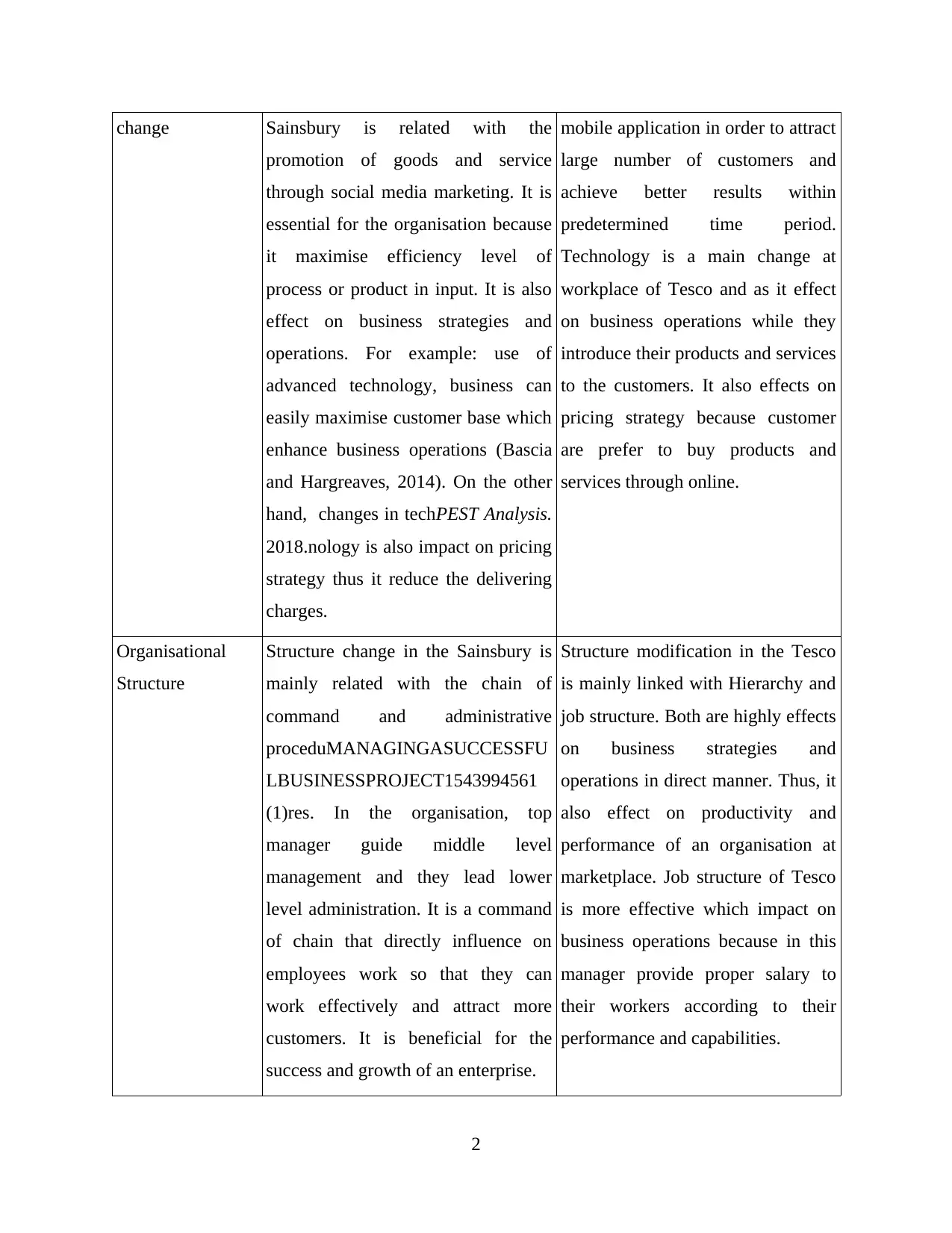
change Sainsbury is related with the
promotion of goods and service
through social media marketing. It is
essential for the organisation because
it maximise efficiency level of
process or product in input. It is also
effect on business strategies and
operations. For example: use of
advanced technology, business can
easily maximise customer base which
enhance business operations (Bascia
and Hargreaves, 2014). On the other
hand, changes in techPEST Analysis.
2018.nology is also impact on pricing
strategy thus it reduce the delivering
charges.
mobile application in order to attract
large number of customers and
achieve better results within
predetermined time period.
Technology is a main change at
workplace of Tesco and as it effect
on business operations while they
introduce their products and services
to the customers. It also effects on
pricing strategy because customer
are prefer to buy products and
services through online.
Organisational
Structure
Structure change in the Sainsbury is
mainly related with the chain of
command and administrative
proceduMANAGINGASUCCESSFU
LBUSINESSPROJECT1543994561
(1)res. In the organisation, top
manager guide middle level
management and they lead lower
level administration. It is a command
of chain that directly influence on
employees work so that they can
work effectively and attract more
customers. It is beneficial for the
success and growth of an enterprise.
Structure modification in the Tesco
is mainly linked with Hierarchy and
job structure. Both are highly effects
on business strategies and
operations in direct manner. Thus, it
also effect on productivity and
performance of an organisation at
marketplace. Job structure of Tesco
is more effective which impact on
business operations because in this
manager provide proper salary to
their workers according to their
performance and capabilities.
2
promotion of goods and service
through social media marketing. It is
essential for the organisation because
it maximise efficiency level of
process or product in input. It is also
effect on business strategies and
operations. For example: use of
advanced technology, business can
easily maximise customer base which
enhance business operations (Bascia
and Hargreaves, 2014). On the other
hand, changes in techPEST Analysis.
2018.nology is also impact on pricing
strategy thus it reduce the delivering
charges.
mobile application in order to attract
large number of customers and
achieve better results within
predetermined time period.
Technology is a main change at
workplace of Tesco and as it effect
on business operations while they
introduce their products and services
to the customers. It also effects on
pricing strategy because customer
are prefer to buy products and
services through online.
Organisational
Structure
Structure change in the Sainsbury is
mainly related with the chain of
command and administrative
proceduMANAGINGASUCCESSFU
LBUSINESSPROJECT1543994561
(1)res. In the organisation, top
manager guide middle level
management and they lead lower
level administration. It is a command
of chain that directly influence on
employees work so that they can
work effectively and attract more
customers. It is beneficial for the
success and growth of an enterprise.
Structure modification in the Tesco
is mainly linked with Hierarchy and
job structure. Both are highly effects
on business strategies and
operations in direct manner. Thus, it
also effect on productivity and
performance of an organisation at
marketplace. Job structure of Tesco
is more effective which impact on
business operations because in this
manager provide proper salary to
their workers according to their
performance and capabilities.
2
Paraphrase This Document
Need a fresh take? Get an instant paraphrase of this document with our AI Paraphraser
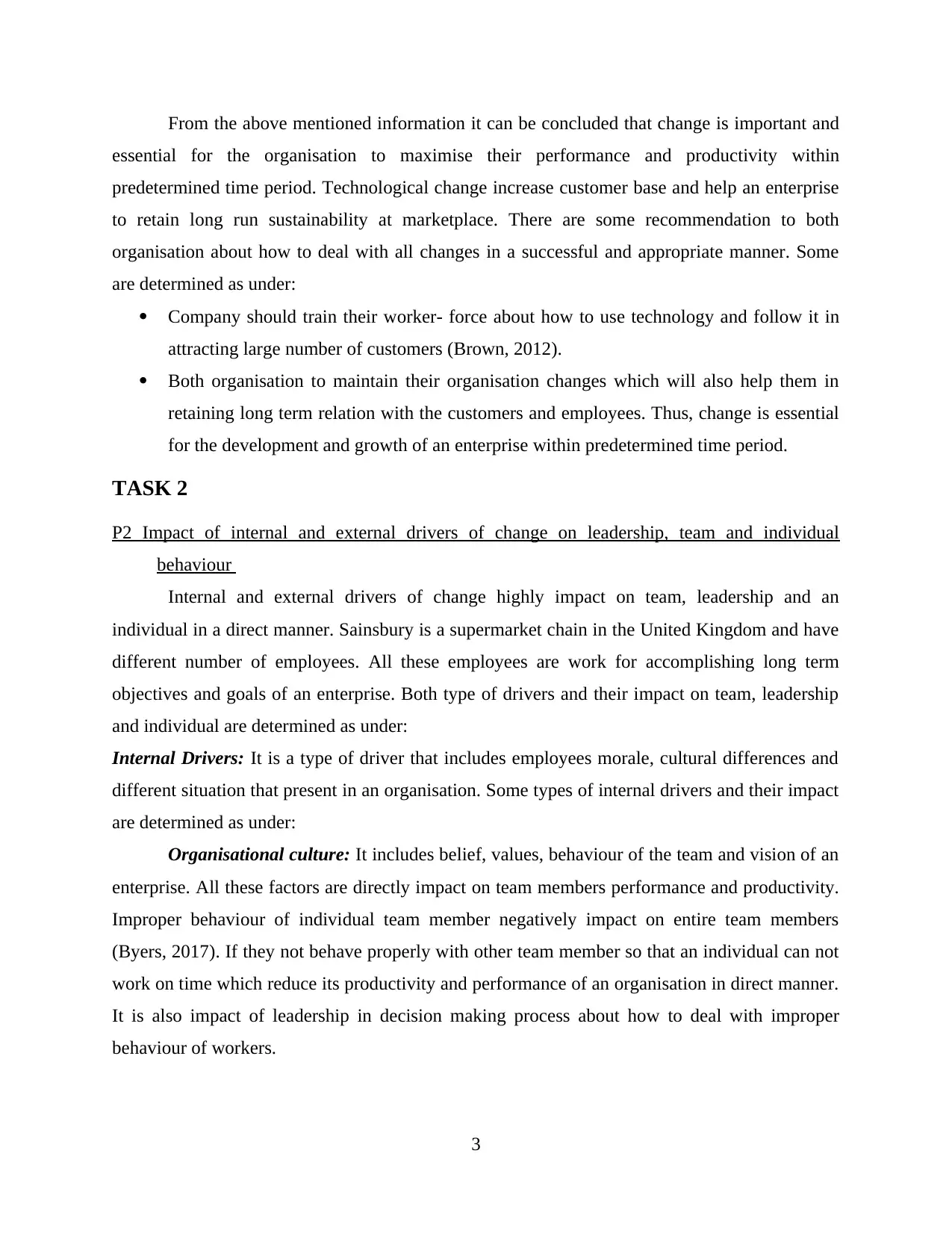
From the above mentioned information it can be concluded that change is important and
essential for the organisation to maximise their performance and productivity within
predetermined time period. Technological change increase customer base and help an enterprise
to retain long run sustainability at marketplace. There are some recommendation to both
organisation about how to deal with all changes in a successful and appropriate manner. Some
are determined as under:
Company should train their worker- force about how to use technology and follow it in
attracting large number of customers (Brown, 2012).
Both organisation to maintain their organisation changes which will also help them in
retaining long term relation with the customers and employees. Thus, change is essential
for the development and growth of an enterprise within predetermined time period.
TASK 2
P2 Impact of internal and external drivers of change on leadership, team and individual
behaviour
Internal and external drivers of change highly impact on team, leadership and an
individual in a direct manner. Sainsbury is a supermarket chain in the United Kingdom and have
different number of employees. All these employees are work for accomplishing long term
objectives and goals of an enterprise. Both type of drivers and their impact on team, leadership
and individual are determined as under:
Internal Drivers: It is a type of driver that includes employees morale, cultural differences and
different situation that present in an organisation. Some types of internal drivers and their impact
are determined as under:
Organisational culture: It includes belief, values, behaviour of the team and vision of an
enterprise. All these factors are directly impact on team members performance and productivity.
Improper behaviour of individual team member negatively impact on entire team members
(Byers, 2017). If they not behave properly with other team member so that an individual can not
work on time which reduce its productivity and performance of an organisation in direct manner.
It is also impact of leadership in decision making process about how to deal with improper
behaviour of workers.
3
essential for the organisation to maximise their performance and productivity within
predetermined time period. Technological change increase customer base and help an enterprise
to retain long run sustainability at marketplace. There are some recommendation to both
organisation about how to deal with all changes in a successful and appropriate manner. Some
are determined as under:
Company should train their worker- force about how to use technology and follow it in
attracting large number of customers (Brown, 2012).
Both organisation to maintain their organisation changes which will also help them in
retaining long term relation with the customers and employees. Thus, change is essential
for the development and growth of an enterprise within predetermined time period.
TASK 2
P2 Impact of internal and external drivers of change on leadership, team and individual
behaviour
Internal and external drivers of change highly impact on team, leadership and an
individual in a direct manner. Sainsbury is a supermarket chain in the United Kingdom and have
different number of employees. All these employees are work for accomplishing long term
objectives and goals of an enterprise. Both type of drivers and their impact on team, leadership
and individual are determined as under:
Internal Drivers: It is a type of driver that includes employees morale, cultural differences and
different situation that present in an organisation. Some types of internal drivers and their impact
are determined as under:
Organisational culture: It includes belief, values, behaviour of the team and vision of an
enterprise. All these factors are directly impact on team members performance and productivity.
Improper behaviour of individual team member negatively impact on entire team members
(Byers, 2017). If they not behave properly with other team member so that an individual can not
work on time which reduce its productivity and performance of an organisation in direct manner.
It is also impact of leadership in decision making process about how to deal with improper
behaviour of workers.
3
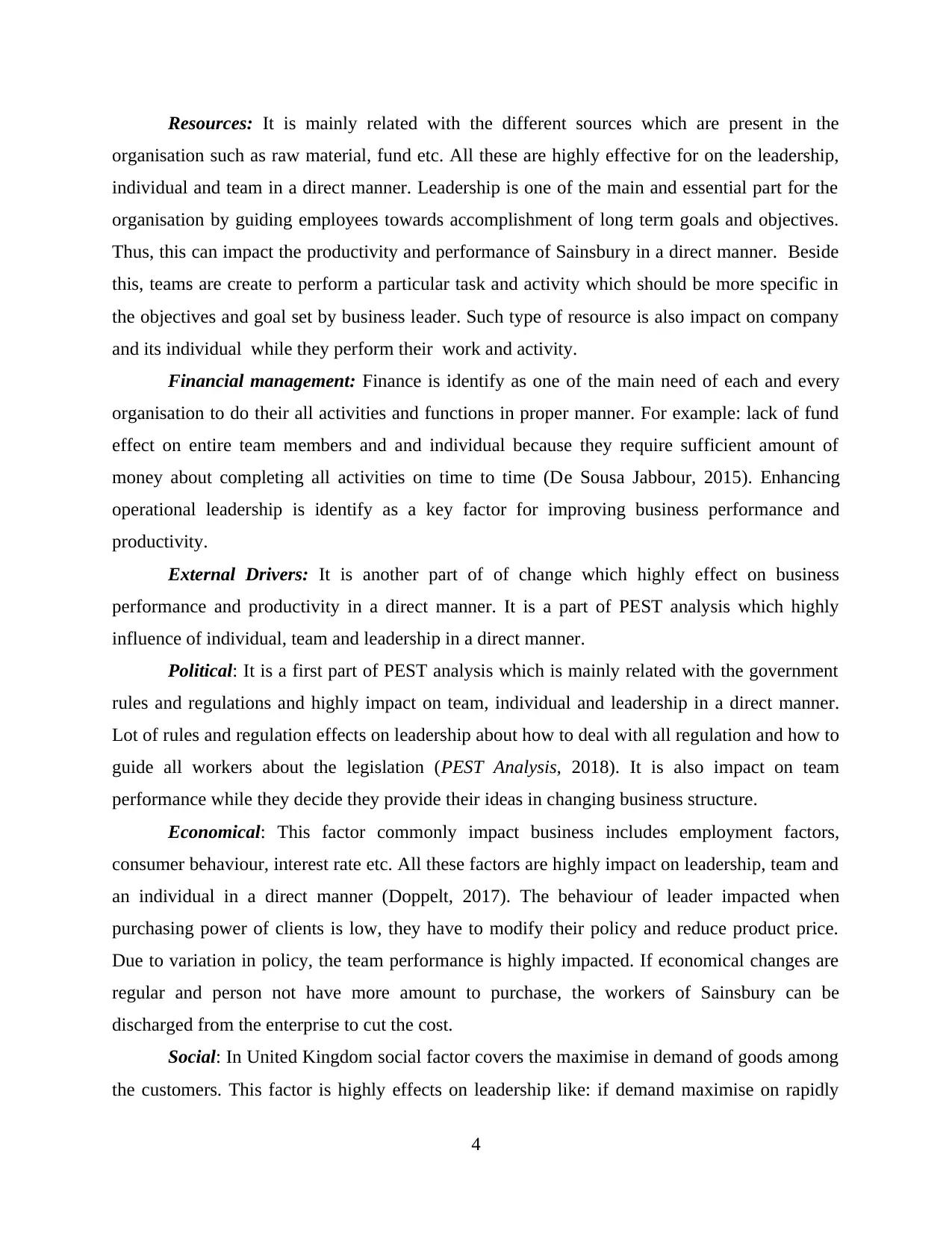
Resources: It is mainly related with the different sources which are present in the
organisation such as raw material, fund etc. All these are highly effective for on the leadership,
individual and team in a direct manner. Leadership is one of the main and essential part for the
organisation by guiding employees towards accomplishment of long term goals and objectives.
Thus, this can impact the productivity and performance of Sainsbury in a direct manner. Beside
this, teams are create to perform a particular task and activity which should be more specific in
the objectives and goal set by business leader. Such type of resource is also impact on company
and its individual while they perform their work and activity.
Financial management: Finance is identify as one of the main need of each and every
organisation to do their all activities and functions in proper manner. For example: lack of fund
effect on entire team members and and individual because they require sufficient amount of
money about completing all activities on time to time (De Sousa Jabbour, 2015). Enhancing
operational leadership is identify as a key factor for improving business performance and
productivity.
External Drivers: It is another part of of change which highly effect on business
performance and productivity in a direct manner. It is a part of PEST analysis which highly
influence of individual, team and leadership in a direct manner.
Political: It is a first part of PEST analysis which is mainly related with the government
rules and regulations and highly impact on team, individual and leadership in a direct manner.
Lot of rules and regulation effects on leadership about how to deal with all regulation and how to
guide all workers about the legislation (PEST Analysis, 2018). It is also impact on team
performance while they decide they provide their ideas in changing business structure.
Economical: This factor commonly impact business includes employment factors,
consumer behaviour, interest rate etc. All these factors are highly impact on leadership, team and
an individual in a direct manner (Doppelt, 2017). The behaviour of leader impacted when
purchasing power of clients is low, they have to modify their policy and reduce product price.
Due to variation in policy, the team performance is highly impacted. If economical changes are
regular and person not have more amount to purchase, the workers of Sainsbury can be
discharged from the enterprise to cut the cost.
Social: In United Kingdom social factor covers the maximise in demand of goods among
the customers. This factor is highly effects on leadership like: if demand maximise on rapidly
4
organisation such as raw material, fund etc. All these are highly effective for on the leadership,
individual and team in a direct manner. Leadership is one of the main and essential part for the
organisation by guiding employees towards accomplishment of long term goals and objectives.
Thus, this can impact the productivity and performance of Sainsbury in a direct manner. Beside
this, teams are create to perform a particular task and activity which should be more specific in
the objectives and goal set by business leader. Such type of resource is also impact on company
and its individual while they perform their work and activity.
Financial management: Finance is identify as one of the main need of each and every
organisation to do their all activities and functions in proper manner. For example: lack of fund
effect on entire team members and and individual because they require sufficient amount of
money about completing all activities on time to time (De Sousa Jabbour, 2015). Enhancing
operational leadership is identify as a key factor for improving business performance and
productivity.
External Drivers: It is another part of of change which highly effect on business
performance and productivity in a direct manner. It is a part of PEST analysis which highly
influence of individual, team and leadership in a direct manner.
Political: It is a first part of PEST analysis which is mainly related with the government
rules and regulations and highly impact on team, individual and leadership in a direct manner.
Lot of rules and regulation effects on leadership about how to deal with all regulation and how to
guide all workers about the legislation (PEST Analysis, 2018). It is also impact on team
performance while they decide they provide their ideas in changing business structure.
Economical: This factor commonly impact business includes employment factors,
consumer behaviour, interest rate etc. All these factors are highly impact on leadership, team and
an individual in a direct manner (Doppelt, 2017). The behaviour of leader impacted when
purchasing power of clients is low, they have to modify their policy and reduce product price.
Due to variation in policy, the team performance is highly impacted. If economical changes are
regular and person not have more amount to purchase, the workers of Sainsbury can be
discharged from the enterprise to cut the cost.
Social: In United Kingdom social factor covers the maximise in demand of goods among
the customers. This factor is highly effects on leadership like: if demand maximise on rapidly
4
⊘ This is a preview!⊘
Do you want full access?
Subscribe today to unlock all pages.

Trusted by 1+ million students worldwide
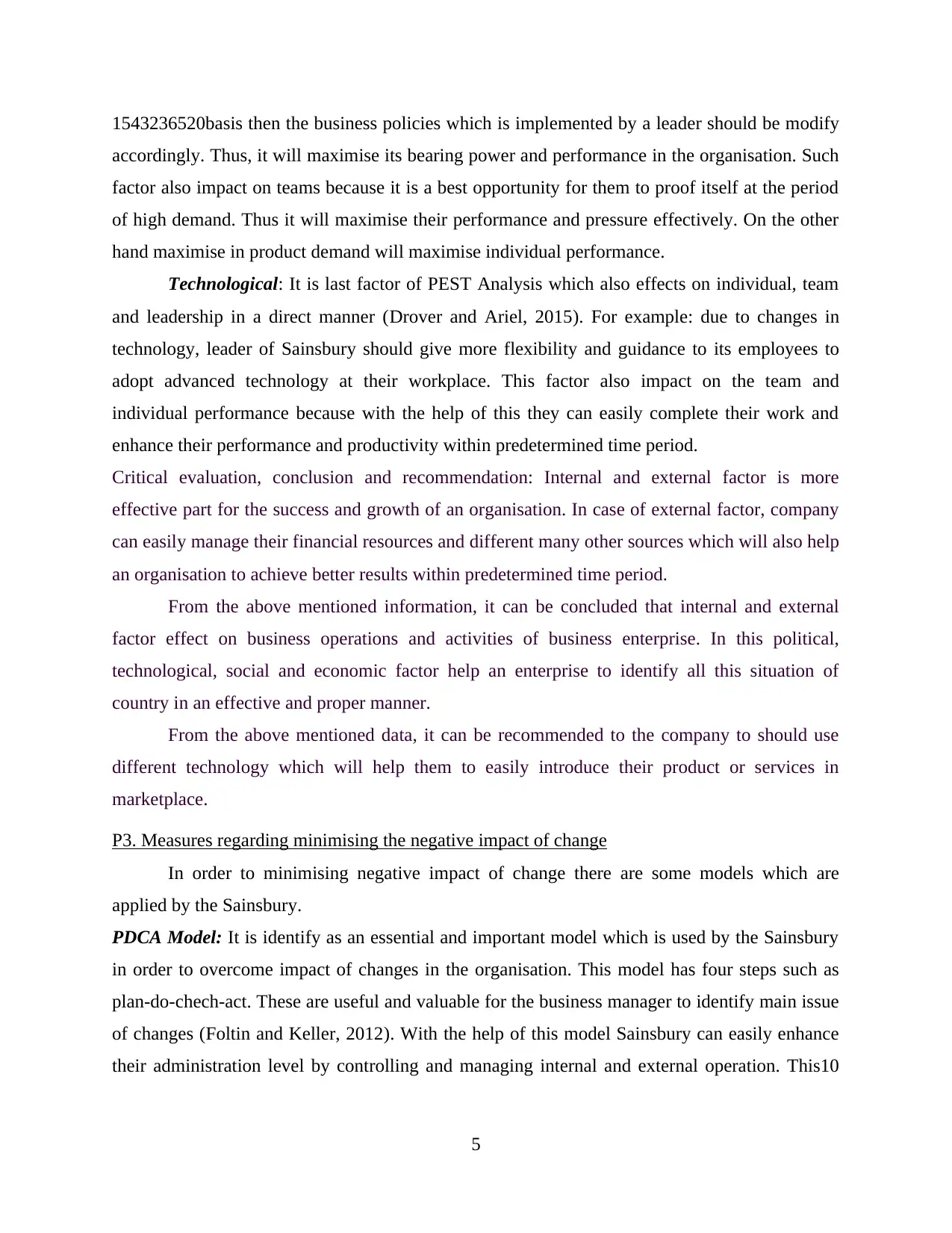
1543236520basis then the business policies which is implemented by a leader should be modify
accordingly. Thus, it will maximise its bearing power and performance in the organisation. Such
factor also impact on teams because it is a best opportunity for them to proof itself at the period
of high demand. Thus it will maximise their performance and pressure effectively. On the other
hand maximise in product demand will maximise individual performance.
Technological: It is last factor of PEST Analysis which also effects on individual, team
and leadership in a direct manner (Drover and Ariel, 2015). For example: due to changes in
technology, leader of Sainsbury should give more flexibility and guidance to its employees to
adopt advanced technology at their workplace. This factor also impact on the team and
individual performance because with the help of this they can easily complete their work and
enhance their performance and productivity within predetermined time period.
Critical evaluation, conclusion and recommendation: Internal and external factor is more
effective part for the success and growth of an organisation. In case of external factor, company
can easily manage their financial resources and different many other sources which will also help
an organisation to achieve better results within predetermined time period.
From the above mentioned information, it can be concluded that internal and external
factor effect on business operations and activities of business enterprise. In this political,
technological, social and economic factor help an enterprise to identify all this situation of
country in an effective and proper manner.
From the above mentioned data, it can be recommended to the company to should use
different technology which will help them to easily introduce their product or services in
marketplace.
P3. Measures regarding minimising the negative impact of change
In order to minimising negative impact of change there are some models which are
applied by the Sainsbury.
PDCA Model: It is identify as an essential and important model which is used by the Sainsbury
in order to overcome impact of changes in the organisation. This model has four steps such as
plan-do-chech-act. These are useful and valuable for the business manager to identify main issue
of changes (Foltin and Keller, 2012). With the help of this model Sainsbury can easily enhance
their administration level by controlling and managing internal and external operation. This10
5
accordingly. Thus, it will maximise its bearing power and performance in the organisation. Such
factor also impact on teams because it is a best opportunity for them to proof itself at the period
of high demand. Thus it will maximise their performance and pressure effectively. On the other
hand maximise in product demand will maximise individual performance.
Technological: It is last factor of PEST Analysis which also effects on individual, team
and leadership in a direct manner (Drover and Ariel, 2015). For example: due to changes in
technology, leader of Sainsbury should give more flexibility and guidance to its employees to
adopt advanced technology at their workplace. This factor also impact on the team and
individual performance because with the help of this they can easily complete their work and
enhance their performance and productivity within predetermined time period.
Critical evaluation, conclusion and recommendation: Internal and external factor is more
effective part for the success and growth of an organisation. In case of external factor, company
can easily manage their financial resources and different many other sources which will also help
an organisation to achieve better results within predetermined time period.
From the above mentioned information, it can be concluded that internal and external
factor effect on business operations and activities of business enterprise. In this political,
technological, social and economic factor help an enterprise to identify all this situation of
country in an effective and proper manner.
From the above mentioned data, it can be recommended to the company to should use
different technology which will help them to easily introduce their product or services in
marketplace.
P3. Measures regarding minimising the negative impact of change
In order to minimising negative impact of change there are some models which are
applied by the Sainsbury.
PDCA Model: It is identify as an essential and important model which is used by the Sainsbury
in order to overcome impact of changes in the organisation. This model has four steps such as
plan-do-chech-act. These are useful and valuable for the business manager to identify main issue
of changes (Foltin and Keller, 2012). With the help of this model Sainsbury can easily enhance
their administration level by controlling and managing internal and external operation. This10
5
Paraphrase This Document
Need a fresh take? Get an instant paraphrase of this document with our AI Paraphraser
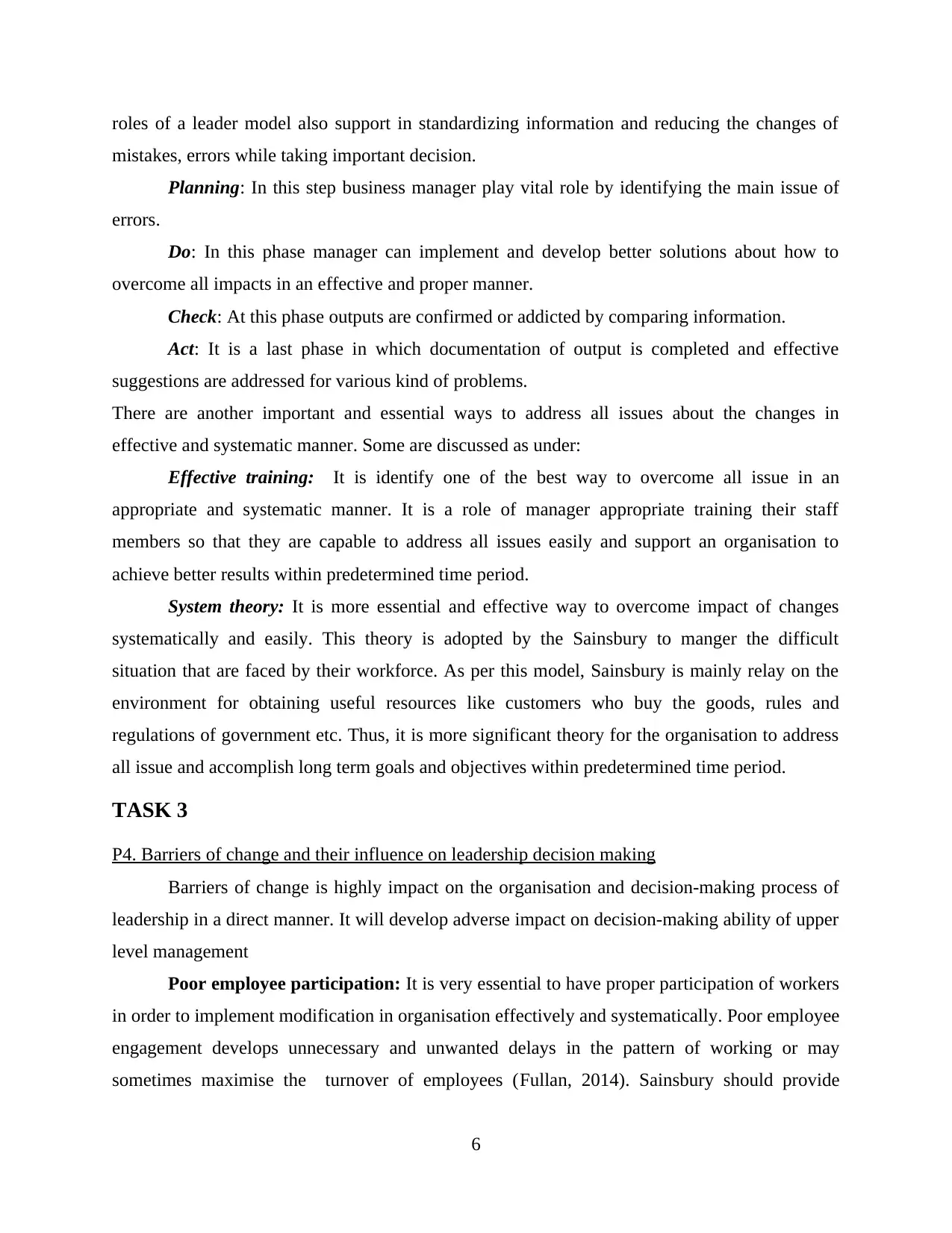
roles of a leader model also support in standardizing information and reducing the changes of
mistakes, errors while taking important decision.
Planning: In this step business manager play vital role by identifying the main issue of
errors.
Do: In this phase manager can implement and develop better solutions about how to
overcome all impacts in an effective and proper manner.
Check: At this phase outputs are confirmed or addicted by comparing information.
Act: It is a last phase in which documentation of output is completed and effective
suggestions are addressed for various kind of problems.
There are another important and essential ways to address all issues about the changes in
effective and systematic manner. Some are discussed as under:
Effective training: It is identify one of the best way to overcome all issue in an
appropriate and systematic manner. It is a role of manager appropriate training their staff
members so that they are capable to address all issues easily and support an organisation to
achieve better results within predetermined time period.
System theory: It is more essential and effective way to overcome impact of changes
systematically and easily. This theory is adopted by the Sainsbury to manger the difficult
situation that are faced by their workforce. As per this model, Sainsbury is mainly relay on the
environment for obtaining useful resources like customers who buy the goods, rules and
regulations of government etc. Thus, it is more significant theory for the organisation to address
all issue and accomplish long term goals and objectives within predetermined time period.
TASK 3
P4. Barriers of change and their influence on leadership decision making
Barriers of change is highly impact on the organisation and decision-making process of
leadership in a direct manner. It will develop adverse impact on decision-making ability of upper
level management
Poor employee participation: It is very essential to have proper participation of workers
in order to implement modification in organisation effectively and systematically. Poor employee
engagement develops unnecessary and unwanted delays in the pattern of working or may
sometimes maximise the turnover of employees (Fullan, 2014). Sainsbury should provide
6
mistakes, errors while taking important decision.
Planning: In this step business manager play vital role by identifying the main issue of
errors.
Do: In this phase manager can implement and develop better solutions about how to
overcome all impacts in an effective and proper manner.
Check: At this phase outputs are confirmed or addicted by comparing information.
Act: It is a last phase in which documentation of output is completed and effective
suggestions are addressed for various kind of problems.
There are another important and essential ways to address all issues about the changes in
effective and systematic manner. Some are discussed as under:
Effective training: It is identify one of the best way to overcome all issue in an
appropriate and systematic manner. It is a role of manager appropriate training their staff
members so that they are capable to address all issues easily and support an organisation to
achieve better results within predetermined time period.
System theory: It is more essential and effective way to overcome impact of changes
systematically and easily. This theory is adopted by the Sainsbury to manger the difficult
situation that are faced by their workforce. As per this model, Sainsbury is mainly relay on the
environment for obtaining useful resources like customers who buy the goods, rules and
regulations of government etc. Thus, it is more significant theory for the organisation to address
all issue and accomplish long term goals and objectives within predetermined time period.
TASK 3
P4. Barriers of change and their influence on leadership decision making
Barriers of change is highly impact on the organisation and decision-making process of
leadership in a direct manner. It will develop adverse impact on decision-making ability of upper
level management
Poor employee participation: It is very essential to have proper participation of workers
in order to implement modification in organisation effectively and systematically. Poor employee
engagement develops unnecessary and unwanted delays in the pattern of working or may
sometimes maximise the turnover of employees (Fullan, 2014). Sainsbury should provide
6
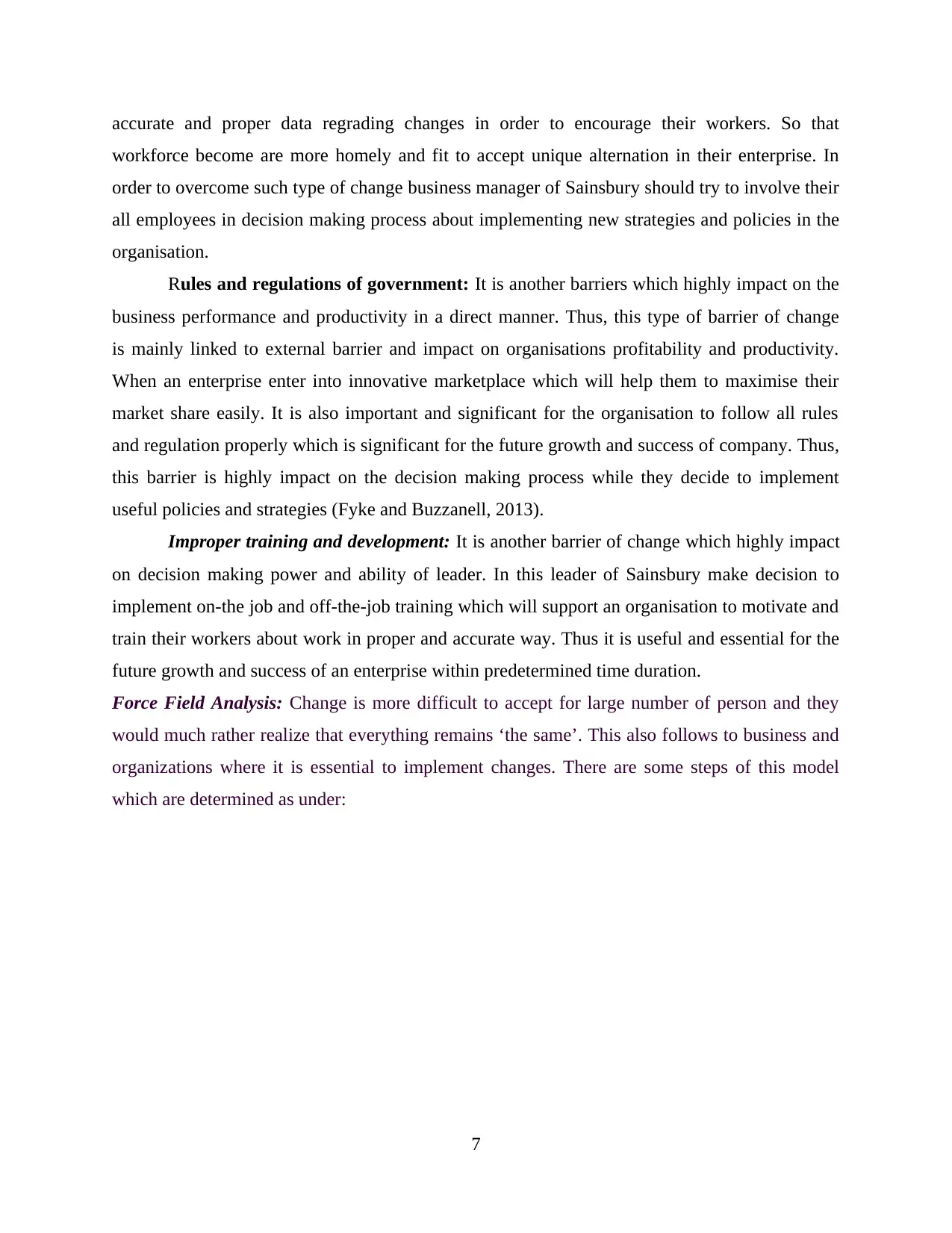
accurate and proper data regrading changes in order to encourage their workers. So that
workforce become are more homely and fit to accept unique alternation in their enterprise. In
order to overcome such type of change business manager of Sainsbury should try to involve their
all employees in decision making process about implementing new strategies and policies in the
organisation.
Rules and regulations of government: It is another barriers which highly impact on the
business performance and productivity in a direct manner. Thus, this type of barrier of change
is mainly linked to external barrier and impact on organisations profitability and productivity.
When an enterprise enter into innovative marketplace which will help them to maximise their
market share easily. It is also important and significant for the organisation to follow all rules
and regulation properly which is significant for the future growth and success of company. Thus,
this barrier is highly impact on the decision making process while they decide to implement
useful policies and strategies (Fyke and Buzzanell, 2013).
Improper training and development: It is another barrier of change which highly impact
on decision making power and ability of leader. In this leader of Sainsbury make decision to
implement on-the job and off-the-job training which will support an organisation to motivate and
train their workers about work in proper and accurate way. Thus it is useful and essential for the
future growth and success of an enterprise within predetermined time duration.
Force Field Analysis: Change is more difficult to accept for large number of person and they
would much rather realize that everything remains ‘the same’. This also follows to business and
organizations where it is essential to implement changes. There are some steps of this model
which are determined as under:
7
workforce become are more homely and fit to accept unique alternation in their enterprise. In
order to overcome such type of change business manager of Sainsbury should try to involve their
all employees in decision making process about implementing new strategies and policies in the
organisation.
Rules and regulations of government: It is another barriers which highly impact on the
business performance and productivity in a direct manner. Thus, this type of barrier of change
is mainly linked to external barrier and impact on organisations profitability and productivity.
When an enterprise enter into innovative marketplace which will help them to maximise their
market share easily. It is also important and significant for the organisation to follow all rules
and regulation properly which is significant for the future growth and success of company. Thus,
this barrier is highly impact on the decision making process while they decide to implement
useful policies and strategies (Fyke and Buzzanell, 2013).
Improper training and development: It is another barrier of change which highly impact
on decision making power and ability of leader. In this leader of Sainsbury make decision to
implement on-the job and off-the-job training which will support an organisation to motivate and
train their workers about work in proper and accurate way. Thus it is useful and essential for the
future growth and success of an enterprise within predetermined time duration.
Force Field Analysis: Change is more difficult to accept for large number of person and they
would much rather realize that everything remains ‘the same’. This also follows to business and
organizations where it is essential to implement changes. There are some steps of this model
which are determined as under:
7
⊘ This is a preview!⊘
Do you want full access?
Subscribe today to unlock all pages.

Trusted by 1+ million students worldwide
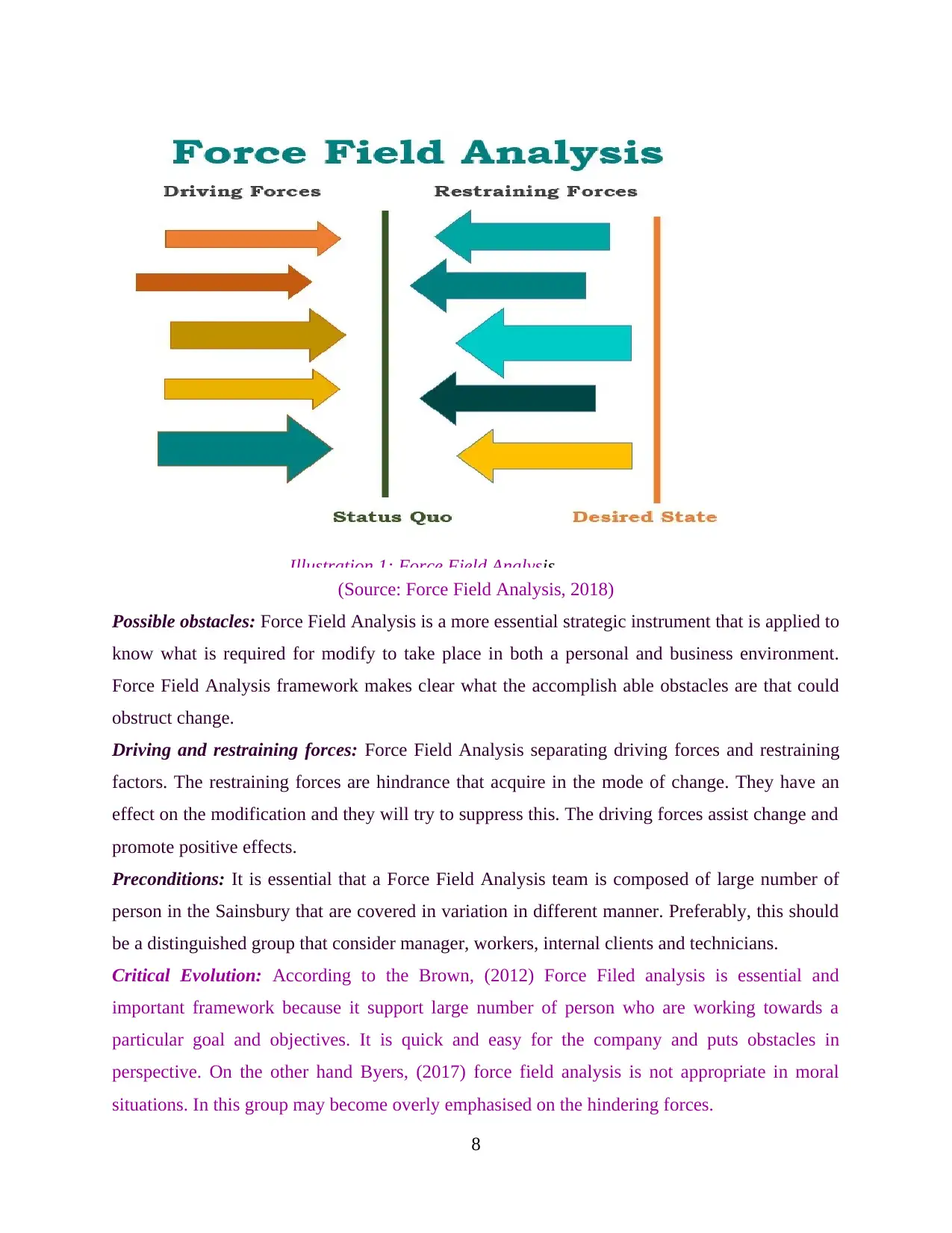
Illustration 1: Force Field Analysis
(Source: Force Field Analysis, 2018)
Possible obstacles: Force Field Analysis is a more essential strategic instrument that is applied to
know what is required for modify to take place in both a personal and business environment.
Force Field Analysis framework makes clear what the accomplish able obstacles are that could
obstruct change.
Driving and restraining forces: Force Field Analysis separating driving forces and restraining
factors. The restraining forces are hindrance that acquire in the mode of change. They have an
effect on the modification and they will try to suppress this. The driving forces assist change and
promote positive effects.
Preconditions: It is essential that a Force Field Analysis team is composed of large number of
person in the Sainsbury that are covered in variation in different manner. Preferably, this should
be a distinguished group that consider manager, workers, internal clients and technicians.
Critical Evolution: According to the Brown, (2012) Force Filed analysis is essential and
important framework because it support large number of person who are working towards a
particular goal and objectives. It is quick and easy for the company and puts obstacles in
perspective. On the other hand Byers, (2017) force field analysis is not appropriate in moral
situations. In this group may become overly emphasised on the hindering forces.
8
(Source: Force Field Analysis, 2018)
Possible obstacles: Force Field Analysis is a more essential strategic instrument that is applied to
know what is required for modify to take place in both a personal and business environment.
Force Field Analysis framework makes clear what the accomplish able obstacles are that could
obstruct change.
Driving and restraining forces: Force Field Analysis separating driving forces and restraining
factors. The restraining forces are hindrance that acquire in the mode of change. They have an
effect on the modification and they will try to suppress this. The driving forces assist change and
promote positive effects.
Preconditions: It is essential that a Force Field Analysis team is composed of large number of
person in the Sainsbury that are covered in variation in different manner. Preferably, this should
be a distinguished group that consider manager, workers, internal clients and technicians.
Critical Evolution: According to the Brown, (2012) Force Filed analysis is essential and
important framework because it support large number of person who are working towards a
particular goal and objectives. It is quick and easy for the company and puts obstacles in
perspective. On the other hand Byers, (2017) force field analysis is not appropriate in moral
situations. In this group may become overly emphasised on the hindering forces.
8
Paraphrase This Document
Need a fresh take? Get an instant paraphrase of this document with our AI Paraphraser
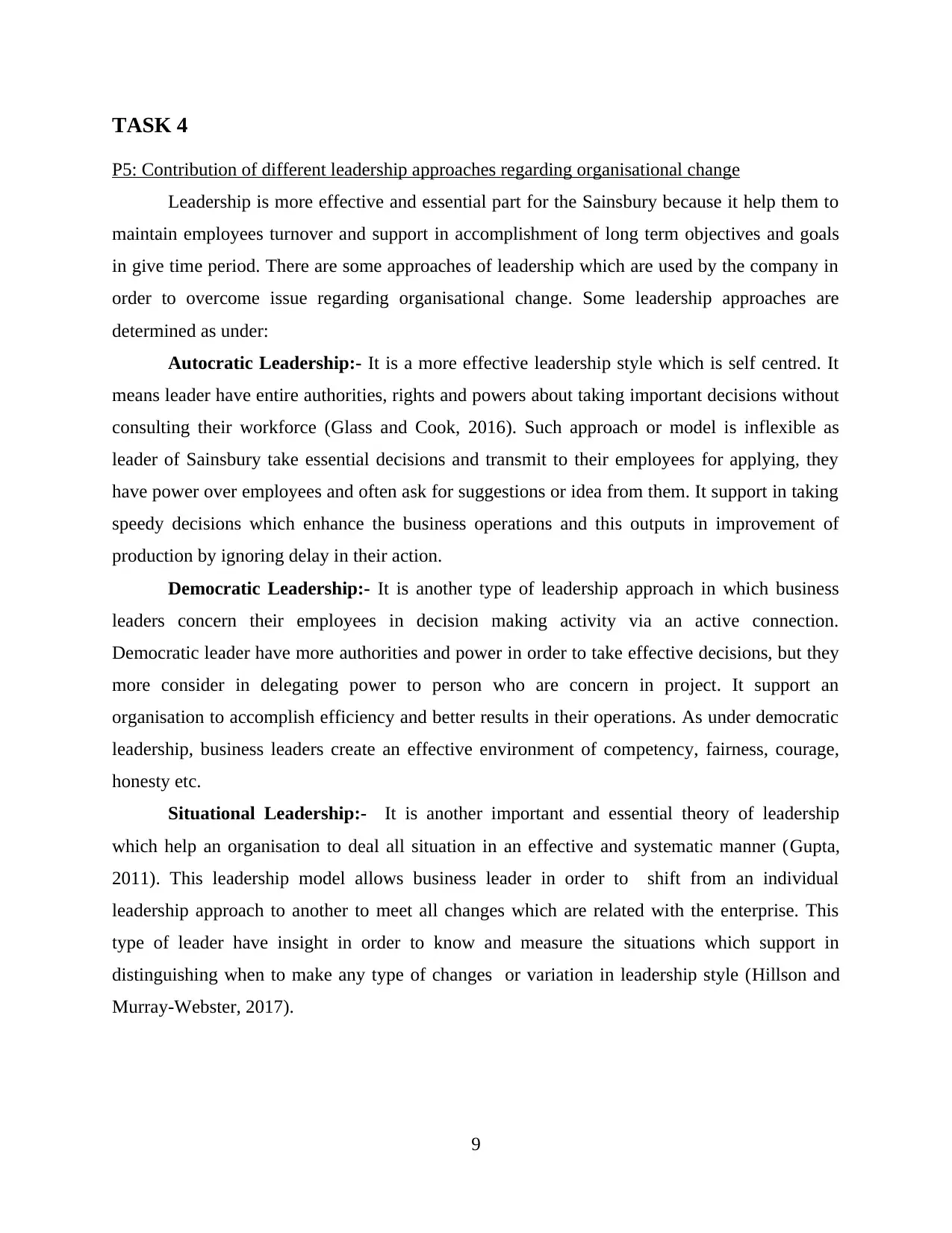
TASK 4
P5: Contribution of different leadership approaches regarding organisational change
Leadership is more effective and essential part for the Sainsbury because it help them to
maintain employees turnover and support in accomplishment of long term objectives and goals
in give time period. There are some approaches of leadership which are used by the company in
order to overcome issue regarding organisational change. Some leadership approaches are
determined as under:
Autocratic Leadership:- It is a more effective leadership style which is self centred. It
means leader have entire authorities, rights and powers about taking important decisions without
consulting their workforce (Glass and Cook, 2016). Such approach or model is inflexible as
leader of Sainsbury take essential decisions and transmit to their employees for applying, they
have power over employees and often ask for suggestions or idea from them. It support in taking
speedy decisions which enhance the business operations and this outputs in improvement of
production by ignoring delay in their action.
Democratic Leadership:- It is another type of leadership approach in which business
leaders concern their employees in decision making activity via an active connection.
Democratic leader have more authorities and power in order to take effective decisions, but they
more consider in delegating power to person who are concern in project. It support an
organisation to accomplish efficiency and better results in their operations. As under democratic
leadership, business leaders create an effective environment of competency, fairness, courage,
honesty etc.
Situational Leadership:- It is another important and essential theory of leadership
which help an organisation to deal all situation in an effective and systematic manner (Gupta,
2011). This leadership model allows business leader in order to shift from an individual
leadership approach to another to meet all changes which are related with the enterprise. This
type of leader have insight in order to know and measure the situations which support in
distinguishing when to make any type of changes or variation in leadership style (Hillson and
Murray-Webster, 2017).
9
P5: Contribution of different leadership approaches regarding organisational change
Leadership is more effective and essential part for the Sainsbury because it help them to
maintain employees turnover and support in accomplishment of long term objectives and goals
in give time period. There are some approaches of leadership which are used by the company in
order to overcome issue regarding organisational change. Some leadership approaches are
determined as under:
Autocratic Leadership:- It is a more effective leadership style which is self centred. It
means leader have entire authorities, rights and powers about taking important decisions without
consulting their workforce (Glass and Cook, 2016). Such approach or model is inflexible as
leader of Sainsbury take essential decisions and transmit to their employees for applying, they
have power over employees and often ask for suggestions or idea from them. It support in taking
speedy decisions which enhance the business operations and this outputs in improvement of
production by ignoring delay in their action.
Democratic Leadership:- It is another type of leadership approach in which business
leaders concern their employees in decision making activity via an active connection.
Democratic leader have more authorities and power in order to take effective decisions, but they
more consider in delegating power to person who are concern in project. It support an
organisation to accomplish efficiency and better results in their operations. As under democratic
leadership, business leaders create an effective environment of competency, fairness, courage,
honesty etc.
Situational Leadership:- It is another important and essential theory of leadership
which help an organisation to deal all situation in an effective and systematic manner (Gupta,
2011). This leadership model allows business leader in order to shift from an individual
leadership approach to another to meet all changes which are related with the enterprise. This
type of leader have insight in order to know and measure the situations which support in
distinguishing when to make any type of changes or variation in leadership style (Hillson and
Murray-Webster, 2017).
9
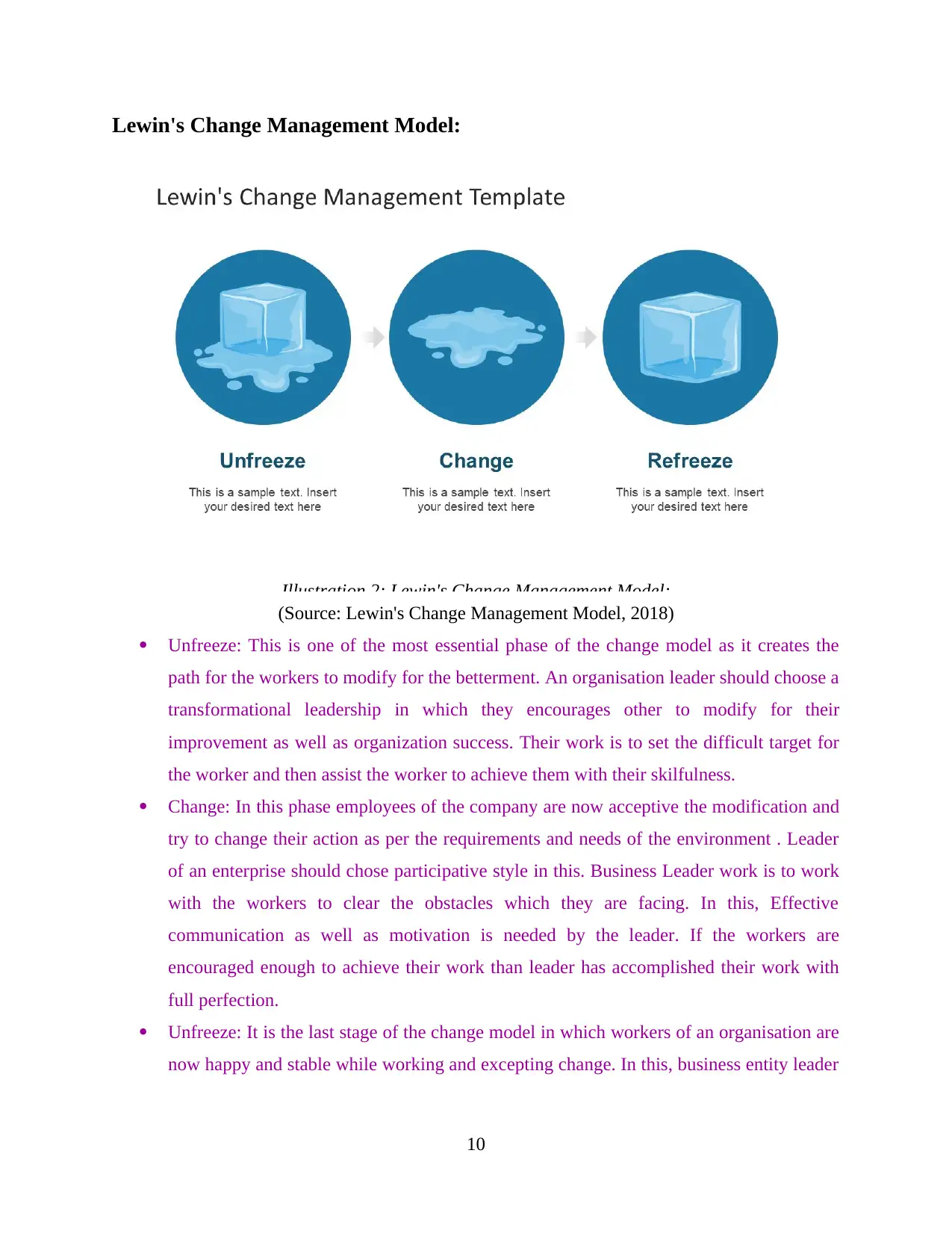
Lewin's Change Management Model:
Illustration 2: Lewin's Change Management Model:
(Source: Lewin's Change Management Model, 2018)
Unfreeze: This is one of the most essential phase of the change model as it creates the
path for the workers to modify for the betterment. An organisation leader should choose a
transformational leadership in which they encourages other to modify for their
improvement as well as organization success. Their work is to set the difficult target for
the worker and then assist the worker to achieve them with their skilfulness.
Change: In this phase employees of the company are now acceptive the modification and
try to change their action as per the requirements and needs of the environment . Leader
of an enterprise should chose participative style in this. Business Leader work is to work
with the workers to clear the obstacles which they are facing. In this, Effective
communication as well as motivation is needed by the leader. If the workers are
encouraged enough to achieve their work than leader has accomplished their work with
full perfection.
Unfreeze: It is the last stage of the change model in which workers of an organisation are
now happy and stable while working and excepting change. In this, business entity leader
10
Illustration 2: Lewin's Change Management Model:
(Source: Lewin's Change Management Model, 2018)
Unfreeze: This is one of the most essential phase of the change model as it creates the
path for the workers to modify for the betterment. An organisation leader should choose a
transformational leadership in which they encourages other to modify for their
improvement as well as organization success. Their work is to set the difficult target for
the worker and then assist the worker to achieve them with their skilfulness.
Change: In this phase employees of the company are now acceptive the modification and
try to change their action as per the requirements and needs of the environment . Leader
of an enterprise should chose participative style in this. Business Leader work is to work
with the workers to clear the obstacles which they are facing. In this, Effective
communication as well as motivation is needed by the leader. If the workers are
encouraged enough to achieve their work than leader has accomplished their work with
full perfection.
Unfreeze: It is the last stage of the change model in which workers of an organisation are
now happy and stable while working and excepting change. In this, business entity leader
10
⊘ This is a preview!⊘
Do you want full access?
Subscribe today to unlock all pages.

Trusted by 1+ million students worldwide
1 out of 14
Related Documents
Your All-in-One AI-Powered Toolkit for Academic Success.
+13062052269
info@desklib.com
Available 24*7 on WhatsApp / Email
![[object Object]](/_next/static/media/star-bottom.7253800d.svg)
Unlock your academic potential
Copyright © 2020–2025 A2Z Services. All Rights Reserved. Developed and managed by ZUCOL.





